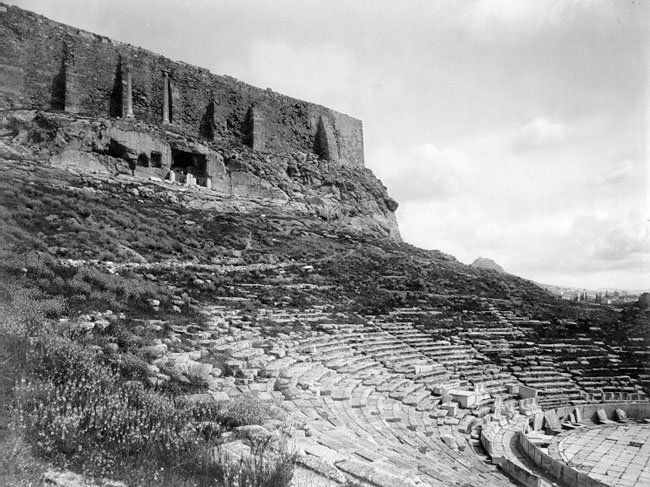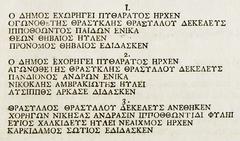
Choragic Monument of Thrasyllos: Visiting Hours, Tickets, and Comprehensive Guide to an Athens Historical Site
Date: 14/06/2025
Introduction
The Choragic Monument of Thrasyllos, set on the southern slope of the Acropolis, stands as a striking symbol of ancient Athens’ dedication to art, civic pride, and religious tradition. Erected around 320–319 BCE by Thrasyllos, an affluent Athenian who funded victorious choral performances during the Dionysian festivals, the monument uniquely merges refined Ionic architecture with the Acropolis’ rugged cliff face. Overlooking the renowned Theatre of Dionysos, it commemorates not just a single victory, but Athens’ broader cultural achievements in drama, public benefaction, and community identity. This guide provides a thorough overview of the monument’s history, architectural features, cultural significance, practical visitor information—including hours, tickets, accessibility, and nearby attractions—and offers valuable travel tips to ensure a memorable visit. For further exploration, authoritative resources such as the Acropolis Museum, Greek Ministry of Culture, and Ancient Athens 3D provide extensive insights.
Table of Contents
- Introduction
- Origins and Construction
- Architectural Features and Innovations
- Historical and Cultural Context
- Later Modifications and Transformations
- Archaeological Investigations and Restoration
- Influence in Art, Literature, and Modern Perception
- Inscriptions and Epigraphic Evidence
- The Monument’s Role in the Acropolis Landscape
- Visiting Information
- Nearby Attractions
- Frequently Asked Questions (FAQ)
- Conclusion and Call to Action
- References and Further Reading
Origins and Construction of the Choragic Monument of Thrasyllos
Commissioned by Thrasyllos, son of Thrasyllos of Dekeleia, the monument was built in 320–319 BCE after a victorious men’s chorus competition during the Dionysia festival (Acropolis Museum). As a choregos—an elite Athenian organizer and sponsor of dramatic choruses—Thrasyllos erected this monument above the Theatre of Dionysos, integrating it into the façade of a natural cave, later known as the Cave of Pan and the Nymphs. Its prominent placement and artistic embellishment underscored the importance of public benefaction and the honor associated with theatrical victories in Athens.
Architectural Features and Innovations
The Choragic Monument of Thrasyllos is notable for its harmonious blend of architecture and landscape. Measuring approximately 6.5 meters wide and 3.5 meters high, its marble façade features two engaged Ionic columns flanking a central doorway, crowned by an entablature and originally topped with a bronze tripod—a symbol of victory in the Dionysian competitions (Acropolis Restoration Service). The monument’s symmetry, elegant volutes, and integration with the natural rock showcase advanced ancient Greek architectural skills. Surviving inscriptions on the frieze provide valuable insight into Athenian festival organization and elite sponsorship (Perseus Digital Library).
Historical and Cultural Context
Choragic monuments like Thrasyllos’ were central to the cultural and religious life of Athens during the Classical and Hellenistic periods. They commemorated both artistic achievement and civic generosity, with the Choragic Monument of Thrasyllos considered among the most elaborate and visually connected to the Theatre of Dionysos below (Greek Ministry of Culture). This alignment emphasized the significance of drama and public celebration in Athenian society.
Later Modifications and Transformations
Over the centuries, the monument’s function and appearance changed. During the Roman and Byzantine periods, the cave behind the monument was converted into a Christian chapel dedicated to Panagia Spiliotissa (Odysseus Portal). In 1802, Lord Elgin removed the original bronze tripod and a statue of Dionysos, which are now housed in Britain (British Museum). The monument suffered further damage during the Greek War of Independence but remained an enduring landmark.
Archaeological Investigations and Restoration
Scholarly interest in the monument began in the late 19th century. Significant restoration efforts took place in 1906 and again in the early 21st century, culminating in a major conservation project completed in 2021 to address structural stability and weathering (Acropolis Museum). Modern restoration ensures the preservation of both original architectural elements and later adaptations.
Influence in Art, Literature, and Modern Perception
The monument’s dramatic façade and unique integration with the Acropolis cliff inspired artists, architects, and travelers from the 18th century onwards, influencing neoclassical design in Europe and America. Iconic engravings, drawings, and photographs by figures such as Stuart and Revett disseminated its image globally (Classicist.org). Today, the monument is recognized as a symbol of Athens’ enduring artistic legacy (Acropolis Museum).
Inscriptions and Epigraphic Evidence
The monument preserves significant inscriptions recording the names of Thrasyllos, the victorious chorus, and the relevant archon, offering a rare glimpse into the civic and festival life of ancient Athens (Perseus Digital Library). These inscriptions are critical for dating the monument and understanding its cultural context.
The Monument’s Role in the Acropolis Landscape
Strategically perched above the Theatre of Dionysos, the monument is part of a network of religious, artistic, and commemorative sites on the Acropolis’ southern slope. Its prominent position ensured visibility from the city and connection to both ancient and later religious practices (Acropolis Museum).
Visiting Information
Visiting Hours and Tickets
The Choragic Monument of Thrasyllos is visible to visitors as part of the Acropolis archaeological site. The Acropolis is generally open daily from 8:00 AM to 8:00 PM in summer and 8:00 AM to 5:00 PM during winter, though hours may vary seasonally. Tickets to the Acropolis site, which include access to the Theatre of Dionysos and views of the monument, are available for approximately €20 (reduced rates for students and seniors). Tickets can be purchased online or at the main entrance (Greek Ministry of Culture, Acropolis Museum).
Accessibility
While the broader Acropolis area has been made more accessible, the path to the Choragic Monument features uneven terrain and steps, which can be challenging for those with mobility impairments. Visitors are advised to wear comfortable footwear and plan for the walk.
Travel Tips and Directions
- Getting There: Enter the Acropolis via Dionysiou Areopagitou Street. The Acropolis Metro station (Line 2) and several bus lines serve the area.
- Best Times to Visit: Early morning or late afternoon provides the best photography lighting and cooler temperatures.
- General Tips: Bring water, sun protection, and consider combining your visit with other nearby sites such as the Theatre of Dionysos, the Stoa of Eumenes, and the Acropolis Museum.
Visual and Interactive Resources
For an enriched experience, consult the Acropolis Museum’s website for high-quality images and virtual tours. Onsite informational panels and reconstructions help visualize the monument’s original appearance.
Nearby Attractions
- Theatre of Dionysos: The birthplace of Greek tragedy, directly below the monument.
- Stoa of Eumenes: A covered walkway and historical structure adjacent to the Acropolis.
- Acropolis Museum: Houses artifacts and exhibits related to the Acropolis monuments (Acropolis Museum).
- Plaka Neighborhood: A lively district with cafes, shops, and neoclassical streets.
- Panagia Spiliotissa Chapel: The Christian chapel behind the monument, open on August 15th.
Frequently Asked Questions (FAQ)
Q: What are the visiting hours for the Choragic Monument of Thrasyllos?
A: It is accessible during Acropolis archaeological site hours: 8:00 AM–8:00 PM in summer, 8:00 AM–5:00 PM in winter. Check the official site for updates.
Q: How much do tickets cost?
A: Admission is included with the Acropolis ticket, about €20 for adults with reductions available.
Q: Is the monument wheelchair accessible?
A: The main Acropolis entrance is accessible, but the path to the monument has uneven terrain and steps.
Q: Can I go inside the monument or the chapel?
A: The monument itself is not open for interior visits. The chapel is open only on August 15th.
Q: Are guided tours available?
A: Yes, many Acropolis tours include the monument; book in advance during peak seasons.
Conclusion and Call to Action
The Choragic Monument of Thrasyllos is a testament to Athens’ artistic achievements, civic values, and enduring legacy as a center of culture and democracy. Its masterful architecture, historical inscriptions, and dramatic location provide a unique window into the ancient city’s soul. To maximize your visit, plan ahead, check current hours and ticket details, and take advantage of expert-led tours and digital resources. Enhance your exploration with the Audiala app for guided tours and insider travel tips, and stay connected through our social media channels for the latest updates on Athens’ historical sites.
References and Further Reading
- Choragic Monument of Thrasyllos, Acropolis Museum, 2021 (Acropolis Museum)
- Choragic Monument of Thrasyllos, Acropolis Restoration Service (YSMA)
- Choragic Monument of Thrasyllos, Perseus Digital Library (Perseus Digital Library)
- Choragic Monument of Thrasyllos, Greek Ministry of Culture (Greek Ministry of Culture)
- Choragic Monument of Thrasyllos, Odysseus Portal (Odysseus Portal)
- Choragic Monument of Thrasyllos, British Museum (British Museum)
- Choragic Monument of Thrasyllos, Wikipedia (Wikipedia)
- Choragic Monument of Thrasyllos, Ancient Athens 3D (Ancient Athens 3D)
- Choragic Monument of Thrasyllos, Classicist.org (Classicist.org)
- Choragic Monument of Thrasyllos, Greece Is (Greece Is)
- Choragic Monument of Thrasyllos, Atlas Obscura (Atlas Obscura)
- Athens Travel Tips, Dave’s Travel Pages (Dave’s Travel Pages)
- Athens24 Guide (Athens24 Guide)
- Acropolis Museum Official Website (Acropolis Museum)
- Greek Ministry of Culture Official Website (Greek Ministry of Culture)





















































































